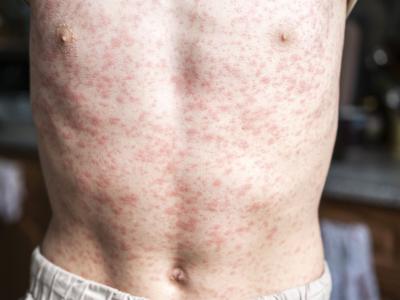Measles clusters grow to 103 cases in New York, New Jersey
The total in three measles clusters—two in New York and one in New Jersey—has grown to 103 cases, according to updates yesterday.
The largest is an outbreak in New York's Rockland County that has now sickened 68 people. The outbreak has been under way since the end of September and was triggered by an international traveler who arrived in the area with a suspected infection. In an update yesterday, Rockland County officials said additional measles cases in infected international travelers have exposed even more people.
Rockland County is located in the New York City suburbs, and the cases are clustered in eastern Ramapo, but, because of the country's small size, officials say exposure could occur anywhere. In response to the outbreak, the county and medical clinics have administered 6,100 doses of measles, mumps, and rubella (MMR) vaccine.
Meanwhile, a measles outbreak centered in the Brooklyn, N.Y., Orthodox Jewish community has grown to 24 confirmed cases, according to NYC Health. The outbreak began in October, with the initial case linked to an unvaccinated child who was exposed to measles on a visit to Israel, where a large outbreak is ongoing.
Elsewhere, a measles cluster in Ocean County, N.J., has now sickened 11 people, according to an update from the New Jersey Department of Health (NJDH). The county announced the first case on Oct 26, involving an individual who contracted measles during international travel.
Nov 13 Rockland County update
Nov 13 NYC Health update
Nov 13 NJDH update
Study examines transfer of bacteria between hospital surfaces, patients
In a study today in Infection Control and Hospital Epidemiology, researchers from Duke University and the University of North Carolina observed the transmission of multidrug-resistant organisms (MDROs) between the hospital environment and patients in nearly 20% of encounters.
In the prospective cohort study, which was conducted at two hospitals, the researchers sought to characterize the nature of bacterial transfer events between patients and environmental surfaces using four "marker" MDROs known for their propensity to contaminate and persist on hospital surfaces: methicillin-resistant Staphylococcus aureus (MRSA), vancomycin-resistant enterococci (VRE), Clostridioides difficile, and multidrug-resistant Acinetobacter baumannii. Although contaminated surfaces are thought to play a role in spreading healthcare-associated infections, the nature, direction, persistence, and quantity of bacterial transfer between surfaces and patients remains poorly understood.
The researchers collected data on 80 patient-room encounters in 68 general ward rooms. Environmental and patient microbiological samples were obtained on admission into a freshly disinfected inpatient room, and repeat samples from room surfaces and patients were taken on days 3 and 7 and each week the patient stayed in the same room. The two primary outcomes of interest were the baseline and subsequent patterns of patient colonization and hospital surface contamination, and the number of microbiologic and molecularly proven bacterial transfer events between hospital surfaces and patients.
In total, 9 patients (11.3%) were asymptomatically colonized with MDROs at study entry. Hospital rooms were contaminated with MDROs despite terminal disinfection in 44 of 80 patient rooms (55%) at the time of study enrollment. The researchers detected microbiologic bacterial transfer events in 12 of 65 patients (18.5%), with 4 occurring from the patient to the environment, 4 occurring from the environment to the patient, and 4 of indeterminate direction. In 2 of the encounters, the patient acquired the MDRO present in the environment at the time of admission.
The study authors conclude, "This study suggests that research on prevention methods beyond the standard practice of room disinfection at the end of a patient's stay is needed to better prevent acquisition of MDROs through the environment."
Nov 14 Infect Control Hosp Epidemiol abstract













